Assessing Matching Characteristics and Spatial Differences between Supply and Demand of Ecosystem Services: A Case Study in Hangzhou, China
Abstract
1. Introduction
2. Materials and Methods
2.1. Study Area
2.2. Data Acquirement and Preparation
2.3. Quantifying the Supply and Demand of Ecosystem Services
2.3.1. Water Yield
2.3.2. Soil Conservation
2.3.3. Carbon Retention
2.3.4. Food Supply
2.3.5. Leisure and Entertainment
2.4. Ecosystem Service Supply and Demand Ratio
2.5. Ecosystem Service Trade-Offs/Synergy Analysis
- 1
- Service capability classification. Since different types of services have different quantity units, they cannot be correlated and compared at the same scale. Therefore, each service is first standardized, and the capacity of each service is divided into three levels, using the natural breakpoint method: low, medium, and high; their corresponding codes are 1, 2, and 3.
- 2
- Service space overlaps. The raster data, after the standardization and classification of the 5 types of services, were superimposed, and the rules are as follows:where W, S, C, F, and L represent the water yield, soil conservation, carbon retention, food supply, and leisure and entertainment services, respectively; CODE is a five-digit code, and each code sequence is a grid value of any combination of 1, 2, and 3, representing the capacity of a corresponding service type.
- 3
- Develop trade-offs/synergy classification standards. The trade-offs are divided into strong trade-offs and weak trade-offs. As shown in Figure 3, a strong trade-off is a state where the service capacity is high and the others are low; a weak trade-off is a state where the capacities (classes) of service types 2, 3, or 4 are high and the other services are low. Synergy is divided into high synergy and low synergy. High synergy means that all five service capabilities are high, which is the most coordinated state and the ultimate goal of ecosystem management; low synergy means that all five service capabilities are low, and this state is the least ideal.
3. Results and Analysis
3.1. Spatial Characteristics of Ecosystem Service Supply and Demand
3.2. Analysis of the Matching of the Supply and Demand of Ecosystem Services
3.3. Tradeoffs between Ecosystem Services
4. Discussion
4.1. Analyzing Mechanisms of the Spatial Difference in ES Supply and Demand
4.2. Mechanisms Influencing ES Supply and Demand Contradictions
4.3. Strengths and Limitations
5. Conclusions
Author Contributions
Funding
Acknowledgments
Conflicts of Interest
Appendix A
| Type of Dataset | Source | Processing | Format |
|---|---|---|---|
| Land use data | Resource and Environmental Science and Data Center of the Chinese Academy of Sciences (http://www.resdc.cn, accessed on 15 August 2020) | Extraction and reclassification | Raster (30 m) |
| Meteorological data | China Meteorological Data Network (http://data.cma.cn, accessed on 20 August 2020) | Kriging interpolation | Raster (30 m) |
| Soil data | Harmonized World Soil Database (HWSD) | Extraction and resampling | Raster (30 m) |
| Socio-economic data | Statistics Bureau of Hangzhou | Collection and summary | Excel |
| Basic geographic information data | China’s geospatial data cloud platform (http://www.gscloud.cn, accessed on 20 August 2020) | Mask extraction | Raster (30 m)Vector |
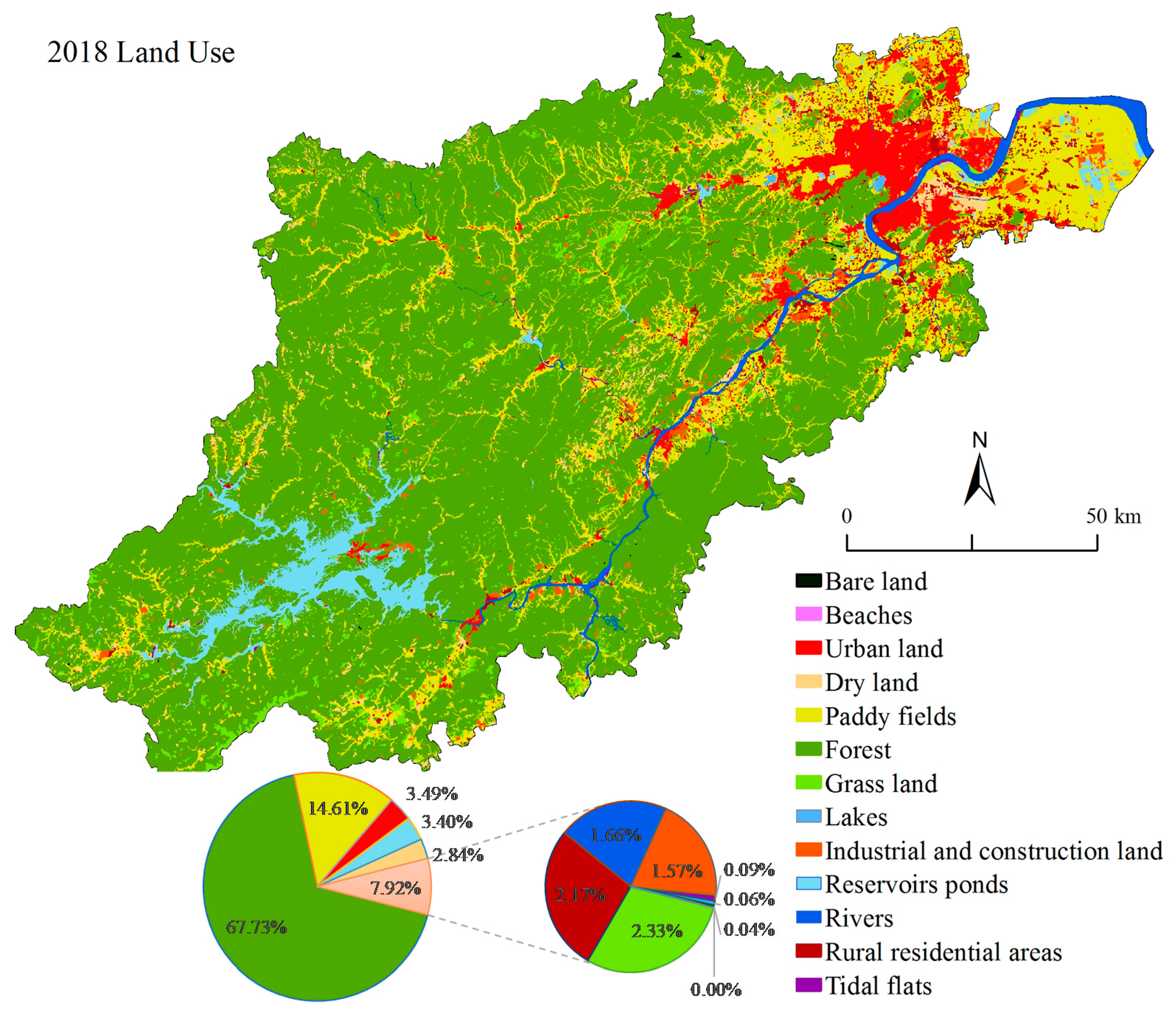
References
- Costanza, R.; d’Arge, R.; De Groot, R.; Farber, S.; Grasso, M.; Hannon, B.; Limburg, K.; N aeem, S.; O’neill, R.V.; Paruelo, J. The value of the world’s ecosystem services and natural capital. Nature 1997, 387, 253–260. [Google Scholar] [CrossRef]
- Reid, W.V.; Mooney, H.A.; Cropper, A.; Capistrano, D.; Carpenter, S.R.; Chopra, K.; Dasgupta, P.; Dietz, T.; Duraiappah, A.K.; Hassan, R.; et al. Ecosystems and Human Well-Being-Synthesis: A Report of the Millennium Ecosystem Assessment; Island Press: Washington, DC, USA, 2005. [Google Scholar]
- Yee, S.H.; Paulukonis, E.; Simmons, C.; Russell, M.; Fulford, R.; Harwell, L.; Smith, L. Projecting effects of land use change on human well-being through changes in ecosystem services. Ecol. Model. 2021, 440, 109358. [Google Scholar] [CrossRef] [PubMed]
- Crossman, N.D.; Burkhard, B.; Nedkov, S.; Willemen, L.; Petz, K.; Palomo, I.; Drakou, E.G.; Martín-Lopez, B.; McPhearson, T.; Boyanova, K. A blueprint for mapping and modelling ecosystem services. Ecosyst. Serv. 2013, 4, 4–14. [Google Scholar] [CrossRef]
- Li, J.; Bai, Y.; Alatalo, J.M. Impacts of rural tourism-driven land use change on ecosystems services provision in Erhai Lake Basin, China. Ecosyst. Serv. 2020, 42, 101081. [Google Scholar] [CrossRef]
- Tian, P.; Cao, L.; Li, J.; Pu, R.; Shi, X.; Wang, L.; Liu, R.; Xu, H.; Tong, C.; Zhou, Z. Landscape grain effect in Yancheng coastal wetland and its response to landscape changes. Int. J. Environ. Res. Public Health 2019, 16, 2225. [Google Scholar] [CrossRef]
- Capriolo, A.; Boschetto, R.; Mascolo, R.; Balbi, S.; Villa, F. Biophysical and economic assessment of four ecosystem services for natural capital accounting in Italy. Ecosyst. Serv. 2020, 46, 101207. [Google Scholar] [CrossRef]
- El Chami, D.; Daccache, A.; El Moujabber, M. What are the impacts of sugarcane production on ecosystem services and human well-being? A review. Ann. Agric. Sci. 2020, 65, 188–199. [Google Scholar] [CrossRef]
- Liu, Y.; Liu, Y.; Li, J.; Sun, C.; Xu, W.; Zhao, B. Trajectory of coastal wetland vegetation in Xiangshan Bay, China, from image time series. Mar. Pollut. Bull. 2020, 160, 111697. [Google Scholar] [CrossRef]
- Ahmadi, M.S.; Sušnik, J.; Veerbeek, W.; Zevenbergen, C. Towards a global day zero? Assessment of current and future water supply and demand in 12 rapidly developing megacities. Sustain. Cities Soc. 2020, 61, 102295. [Google Scholar] [CrossRef]
- Knowlton, J.L.; Halvorsen, K.E.; Flaspohler, D.J.; Webster, C.R.; Abrams, J.; Almeida, S.M.; Arriaga-Weiss, S.L.; Barnett, B.; Cardoso, M.R.; Cerqueira, P.V. Birds and Bioenergy within the Americas: A Cross-National, Social–Ecological Study of Ecosystem Service Tradeoffs. Land 2021, 10, 258. [Google Scholar] [CrossRef]
- Aziz, T. Changes in land use and ecosystem services values in Pakistan, 1950–2050. Environ. Dev. 2020, 37, 100576. [Google Scholar] [CrossRef]
- Landuyt, D.; Broekx, S.; Goethals, P.L. Bayesian belief networks to analyse trade-offs among ecosystem services at the regional scale. Ecol. Indic. 2016, 71, 327–335. [Google Scholar] [CrossRef]
- Costanza, R.; Daly, L.; Fioramonti, L.; Giovannini, E.; Kubiszewski, I.; Mortensen, L.F.; Pickett, K.E.; Ragnarsdottir, K.V.; De Vogli, R.; Wilkinson, R. Modelling and measuring sustainable wellbeing in connection with the UN Sustainable Development Goals. Ecol. Econ. 2016, 130, 350–355. [Google Scholar] [CrossRef]
- Davies, Z.G.; Edmondson, J.L.; Heinemeyer, A.; Leake, J.R.; Gaston, K.J. Mapping an urban ecosystem service: Quantifying above-ground carbon storage at a city-wide scale. J. Appl. Ecol. 2011, 48, 1125–1134. [Google Scholar] [CrossRef]
- Wu, C.; Chen, B.; Huang, X.; Wei, Y.D. Effect of land-use change and optimization on the ecosystem service values of Jiangsu province, China. Ecol. Indic. 2020, 117, 106507. [Google Scholar] [CrossRef]
- Du, X.; Huang, Z. Ecological and environmental effects of land use change in rapid urbanization: The case of hangzhou, China. Ecol. Indic. 2017, 81, 243–251. [Google Scholar] [CrossRef]
- Constant, N.L.; Taylor, P.J. Restoring the forest revives our culture: Ecosystem services and values for ecological restoration across the rural-urban nexus in South Africa. For. Policy Econ. 2020, 118, 102222. [Google Scholar] [CrossRef]
- Larondelle, N.; Lauf, S. Balancing demand and supply of multiple urban ecosystem services on different spatial scales. Ecosyst. Serv. 2016, 22, 18–31. [Google Scholar] [CrossRef]
- Wolff, S.; Schulp, C.; Verburg, P. Mapping ecosystem services demand: A review of current research and future perspectives. Ecol. Indic. 2015, 55, 159–171. [Google Scholar] [CrossRef]
- Yu, C.; Cao, Y.; Li, G.; Tian, Y.; Fang, X.; Li, Y.; Tan, Y. Linking ecosystem services trade-offs, bundles and hotspot identification with cropland management in the coastal Hangzhou Bay area of China. Land Use Policy 2020, 97, 104689. [Google Scholar]
- Sun, W.; Li, D.; Wang, X.; Li, R.; Li, K.; Xie, Y. Exploring the scale effects, trade-offs and driving forces of the mismatch of ecosystem services. Ecol. Indic. 2019, 103, 617–629. [Google Scholar] [CrossRef]
- Kragt, M.E.; Robertson, M.J. Quantifying ecosystem services trade-offs from agricultural practices. Ecol. Econ. 2014, 102, 147–157. [Google Scholar] [CrossRef]
- Wang, J.; Zhou, W.; Pickett, S.T.; Yu, W.; Li, W. A multiscale analysis of urbanization effects on ecosystem services supply in an urban megaregion. Sci. Total Environ. 2019, 662, 824–833. [Google Scholar] [CrossRef]
- Burkhard, B.; Kroll, F.; Nedkov, S.; Müller, F. Mapping ecosystem service supply, demand and budgets. Ecol. Indic. 2012, 21, 17–29. [Google Scholar] [CrossRef]
- Bryan, B.A.; Ye, Y.; Connor, J.D. Land-use change impacts on ecosystem services value: Incorporating the scarcity effects of supply and demand dynamics. Ecosyst. Serv. 2018, 32, 144–157. [Google Scholar] [CrossRef]
- Shen, J.; Du, S.; Huang, Q.; Yin, J.; Zhang, M.; Wen, J.; Gao, J. Mapping the city-scale supply and demand of ecosystem flood regulation services—A case study in Shanghai. Ecol. Indic. 2019, 106, 105544. [Google Scholar] [CrossRef]
- Castro, A.J.; Verburg, P.H.; Martín-López, B.; Garcia-Llorente, M.; Cabello, J.; Vaughn, C.C.; López, E. Ecosystem service trade-offs from supply to social demand: A landscape-scale spatial analysis. Landsc. Urban Plan. 2014, 132, 102–110. [Google Scholar] [CrossRef]
- Benra, F.; Frutos, A.D.; Gaglio, M.; Lvarez-Garretón, C.; Felipe-Lucia, M.; Bonn, A. Mapping water ecosystem services: Evaluating InVEST model predictions in data scarce regions. Environ. Model. Softw. 2021, 138, 104982. [Google Scholar] [CrossRef]
- González-García, A.; Palomo, I.; González, J.; López, C.; Montes, C. Quantifying spatial supply-demand mismatches in ecosystem services provides insights for land-use planning. Land Use Policy 2020, 94, 104493. [Google Scholar] [CrossRef]
- Peng, J.; Wang, X.; Liu, Y.; Zhao, Y.; Xu, Z.; Zhao, M.; Qiu, S.; Wu, J. Urbanization impact on the supply-demand budget of ecosystem services: Decoupling analysis. Ecosyst. Serv. 2020, 44, 101139. [Google Scholar] [CrossRef]
- Hasan, S.S.; Zhen, L.; Miah, M.G.; Ahamed, T.; Samie, A. Impact of land use change on ecosystem services: A review. Environ. Dev. 2020, 34, 100527. [Google Scholar] [CrossRef]
- Lin, W.; Xu, D.; Guo, P.; Wang, D.; Li, L.; Gao, J. Exploring variations of ecosystem service value in Hangzhou Bay Wetland, Eastern China. Ecosyst. Serv. 2019, 37, 100944. [Google Scholar] [CrossRef]
- Wang, C.; Yu, C.; Chen, T.; Feng, Z.; Wu, K. Can the establishment of ecological security patterns improve ecological protection? An example of Nanchang, China. Sci. Total Environ. 2020, 740, 140051. [Google Scholar] [CrossRef]
- Zhang, J.; Zhu, W.; Zhu, L.; Li, Y. Multi-scale analysis of trade-off/synergy effects of forest ecosystem services in the Funiu Mountain Region. Acta Geogr. Sin. 2020, 75, 975–988. [Google Scholar]
- Nachtergaele, F.; Velthuizen, H.; Verelst, L.; Wiberg, D. Harmonized World Soil Database (HWSD); Food Agriculture Organization of the United Nations: Rome, Italy, 2009. [Google Scholar]
- China Economic and Social Big Data Research Platform. 2018. Available online: https://data.cnki.net (accessed on 15 March 2021).
- Redhead, J.; Stratford, C.; Sharps, K.; Jones, L.; Ziv, G.; Clarke, D.; Oliver, T.; Bullock, J. Empirical validation of the InVEST water yield ecosystem service model at a national scale. Sci. Total Environ. 2016, 569, 1418–1426. [Google Scholar] [CrossRef] [PubMed]
- He, S.; Su, Y.; Shahtahmassebi, A.R.; Huang, L.; Zhou, M.; Gan, M.; Deng, J.; Zhao, G.; Wang, K. Assessing and mapping cultural ecosystem services supply, demand and flow of farmlands in the Hangzhou metropolitan area, China. Sci. Total Environ. 2019, 692, 756–768. [Google Scholar] [CrossRef] [PubMed]
- Hangzhou Water Resources Bulletin. 2018. Available online: http://ls.hangzhou.gov.cn (accessed on 15 March 2021).
- Liu, C.; Wang, W.; Liu, L.; Li, P. Supply-demand matching of county ecosystem services in Northwest China: A case study of Gulang county. J. Nat. Resour. 2020, 35, 2177–2190. [Google Scholar]
- Babbar, D.; Areendran, G.; Sahana, M.; Sarma, K.; Raj, K.; Sivadas, A. Assessment and prediction of carbon sequestration using Markov chain and InVEST model in Sariska Tiger Reserve, India. J. Clean. Prod. 2021, 278, 123333. [Google Scholar] [CrossRef]
- Li, Z.; Ren, L.; Ma, R.; Liu, Y.; Yao, D. Temporal and spatial patterns and influencing factors of land use carbon emission at county level in Hangzhou city. Sci. Technol. Manag. 2020, 22, 1–9. [Google Scholar]
- Eggleston, S.; Buendia, L.; Miwa, K.; Ngara, T.; Tanabe, K. (Eds.) Guidelines for National Greenhouse Gas Inventories. Volume 4: Agriculture, Forestry and Other Land Use; IPCC: Geneva, Switzerland, 2006; pp. 9–12. [Google Scholar]
- Liu, L.; Liu, C.; Wang, C.; Li, P. Supply and demand matching of ecosystem services in loess hilly region: A case study of Lanzhou. Prog. Chem. 2019, 74, 1921. [Google Scholar]
- Grossmann, M. Impacts of boating trip limitations on the recreational value of the Spreewald wetland: A pooled revealed/contingent behaviour application of the travel cost method. J. Environ. Plan. Manag. 2011, 54, 211–226. [Google Scholar] [CrossRef]
- Simões, P.; Barata, E.; Cruz, L. Using Count Data and Ordered Models in National Forest Recreation Demand Analysis. Environ. Manag. 2013, 52, 1249–1261. [Google Scholar] [CrossRef] [PubMed]
- Yang, M.; Zhang, Y.; Wang, C. Spatial-temporal Variations in the Supply-demand Balance of Key Ecosystem Services in Hubei Province. Resour. Environ. Yangtze Basin 2019, 28, 2080–2091. [Google Scholar]
- Shi, Y.; Shi, D.; Zhou, L.; Fang, R. Identification of ecosystem services supply and demand areas and simulation of ecosystem service flows in Shanghai. Ecol. Indic. 2020, 115, 106418. [Google Scholar] [CrossRef]
- Costanza, R.; De Groot, R.; Braat, L.; Kubiszewski, I.; Fioramonti, L.; Sutton, P.; Farber, S.; Grasso, M. Twenty years of ecosystem services: How far have we come and how far do we still need to go? Ecosyst. Serv. 2017, 28, 1–16. [Google Scholar] [CrossRef]
- Xu, Q.; Yang, R.; Zhuang, D.; Lu, Z. Spatial gradient differences of ecosystem services supply and demand in the Pearl River Delta region. J. Clean. Prod. 2021, 279, 123849. [Google Scholar] [CrossRef]
- Qingchun, G.; Jinmin, H.; Guoping, R.; Mu, L.; Aiqi, C.; Wenkai, D.; Hong, C. Ecological indexes for the analysis of the spatial-temporal characteristics of ecosystem service supply and demand: A case study of the major grain-producing regions in Quzhou, China. Ecol. Indic. 2020, 108, 105748. [Google Scholar]
- Cao, T.; Yi, Y.; Liu, H.; Xu, Q.; Yang, Z. The relationship between ecosystem service supply and demand in plain areas undergoing urbanization: A case study of China’s Baiyangdian Basin. J. Environ. Manag. 2021, 289, 112492. [Google Scholar] [CrossRef]
- Chen, J.; Jiang, B.; Bai, Y.; Xu, X.; Alatalo, J.M. Quantifying ecosystem services supply and demand shortfalls and mismatches for management optimisation. Sci. Total Environ. 2019, 650, 1426–1439. [Google Scholar] [CrossRef]
- Tao, Y.; Wang, H.; Ou, W.; Guo, J. A land-cover-based approach to assessing ecosystem services supply and demand dynamics in the rapidly urbanizing Yangtze River Delta region. Land Use Policy 2018, 72, 250–258. [Google Scholar] [CrossRef]
- Zhai, T.; Wang, J.; Jin, Z.; Qi, Y.; Fang, Y.; Liu, J. Did improvements of ecosystem services supply-demand imbalance change environmental spatial injustices? Ecol. Indic. 2020, 111, 106068. [Google Scholar] [CrossRef]
- Schulp, C.J.; Lautenbach, S.; Verburg, P.H. Quantifying and mapping ecosystem services: Demand and supply of pollination in the European Union. Ecol. Indic. 2014, 36, 131–141. [Google Scholar] [CrossRef]
- Baró, F.; Haase, D.; Gómez-Baggethun, E.; Frantzeskaki, N. Mismatches between ecosystem services supply and demand in urban areas: A quantitative assessment in five European cities. Ecol. Indic. 2015, 55, 146–158. [Google Scholar] [CrossRef]
- Bae, J.; Ryu, Y. Land use and land cover changes explain spatial and temporal variations of the soil organic carbon stocks in a constructed urban park. Landsc. Urban Plan. 2015, 136, 57–67. [Google Scholar] [CrossRef]
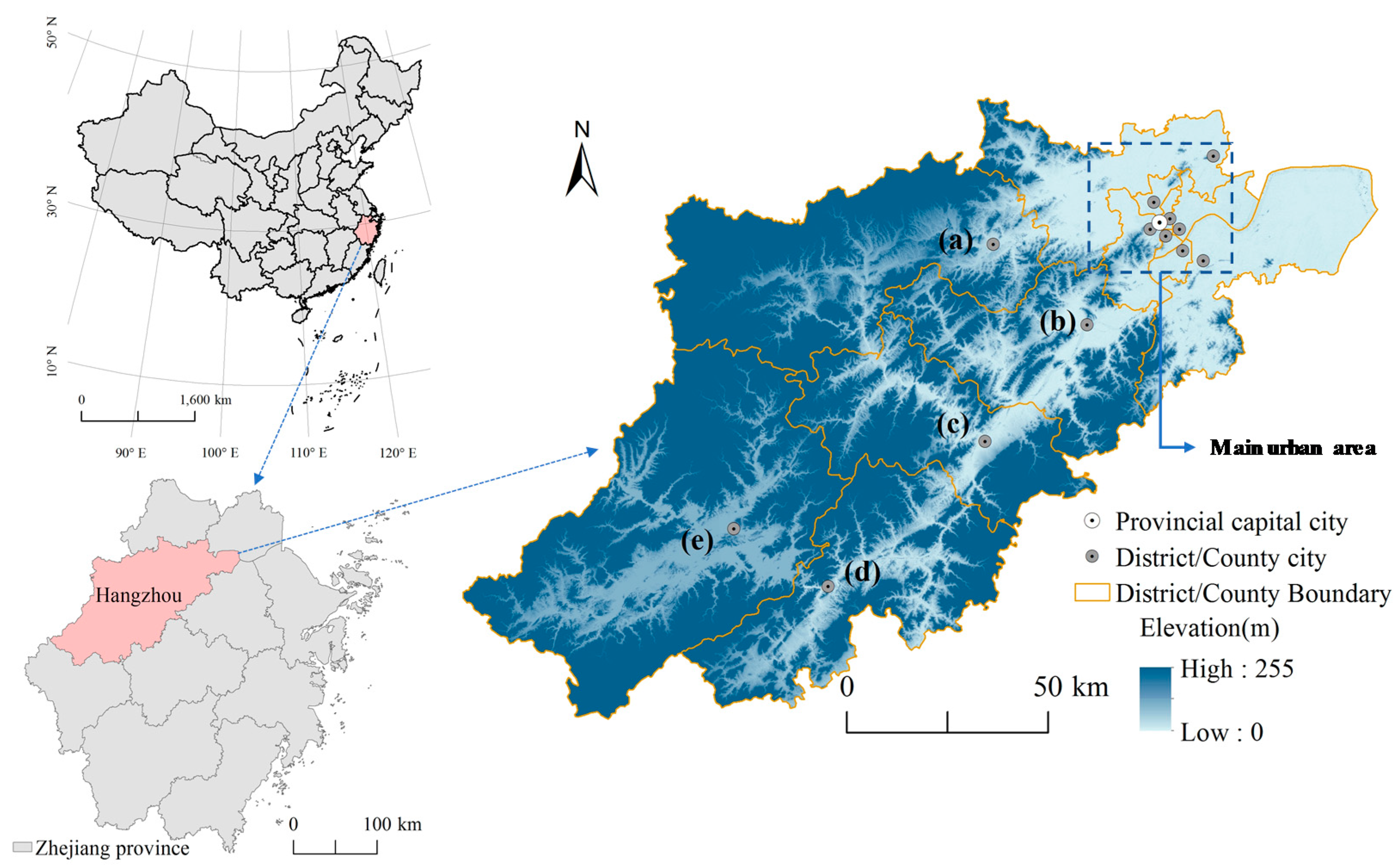
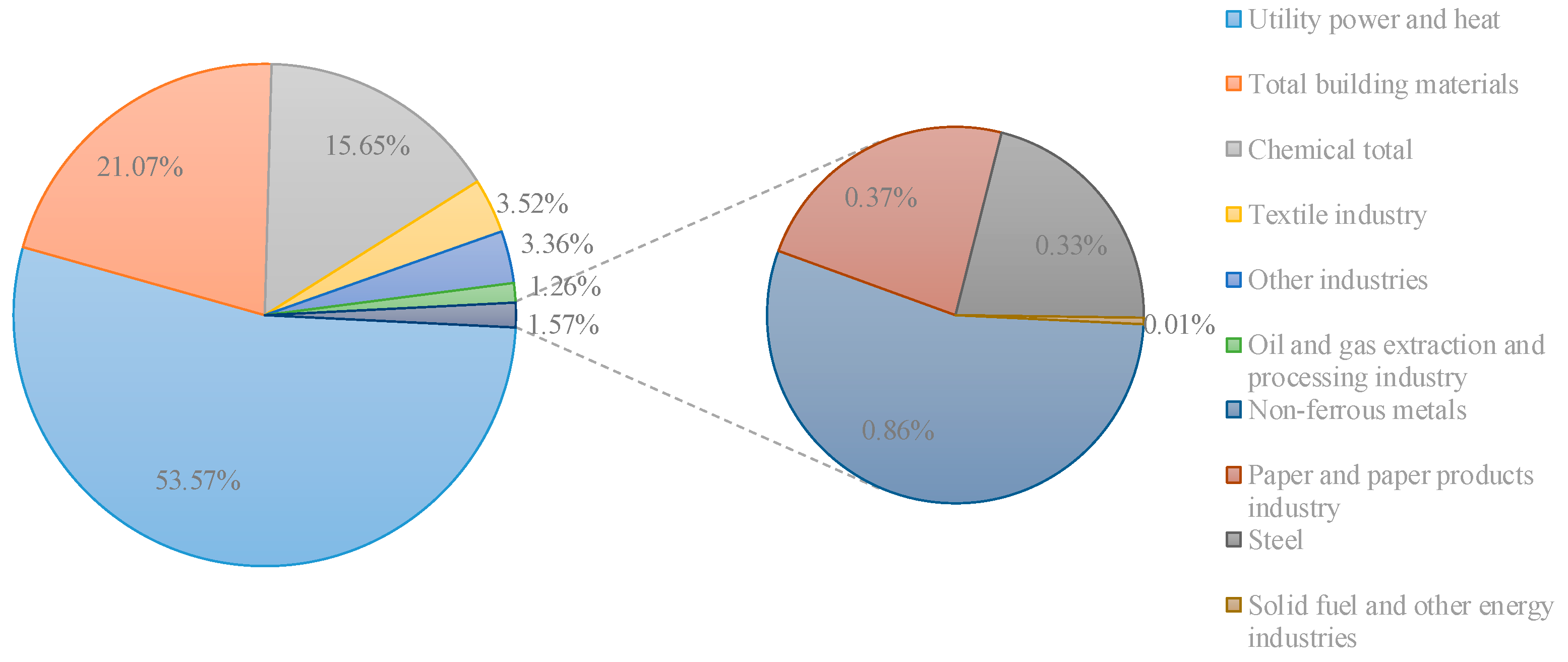
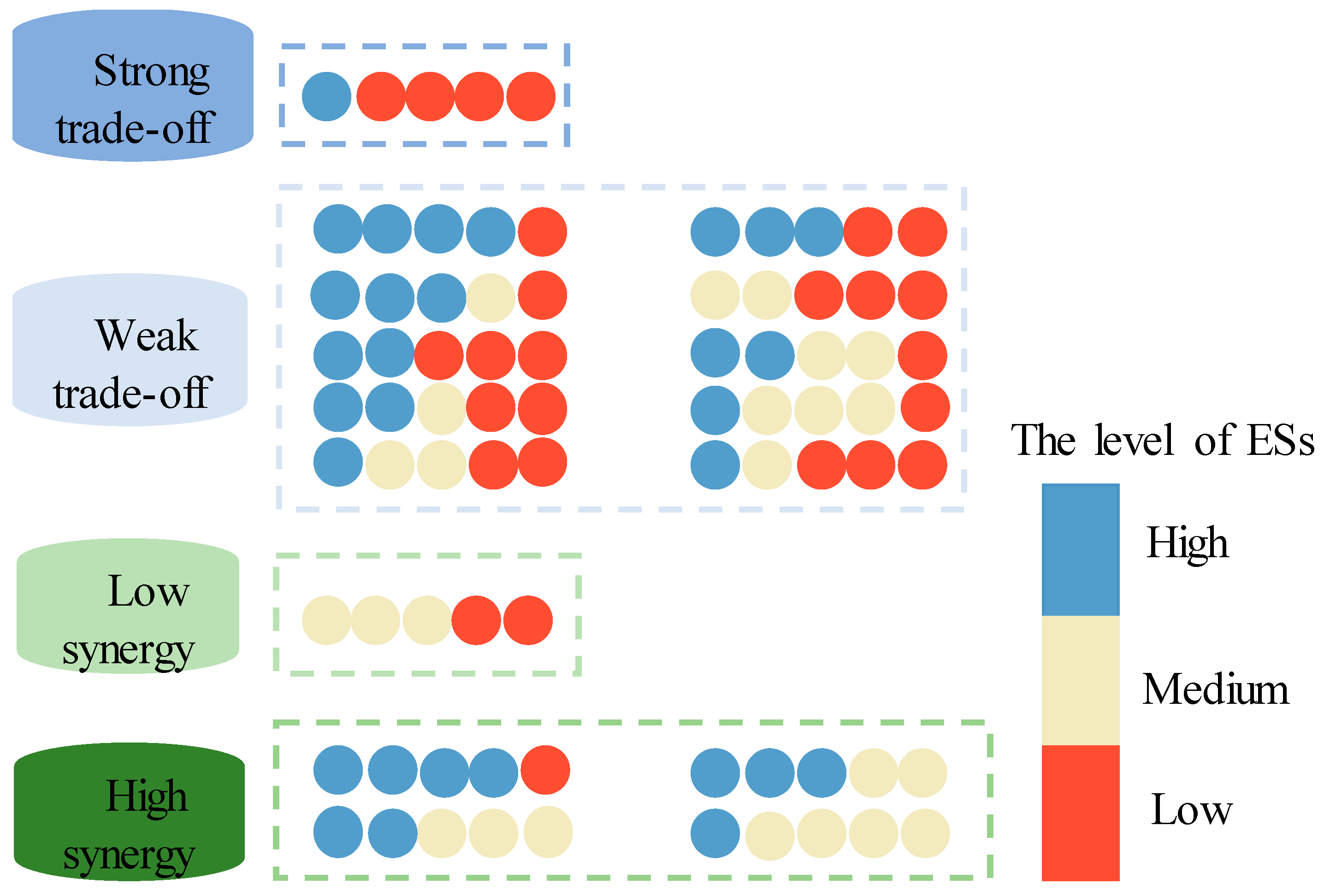
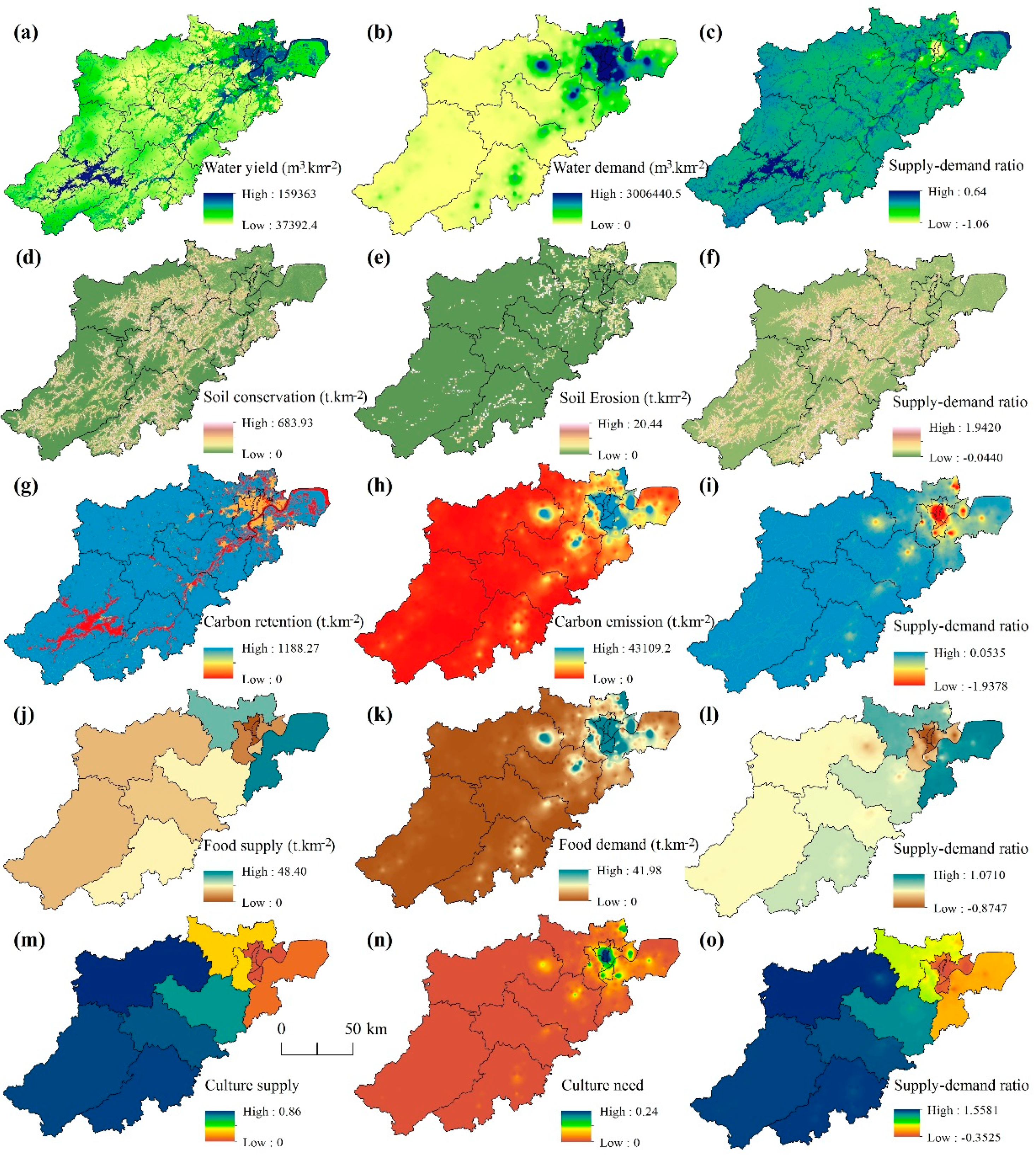
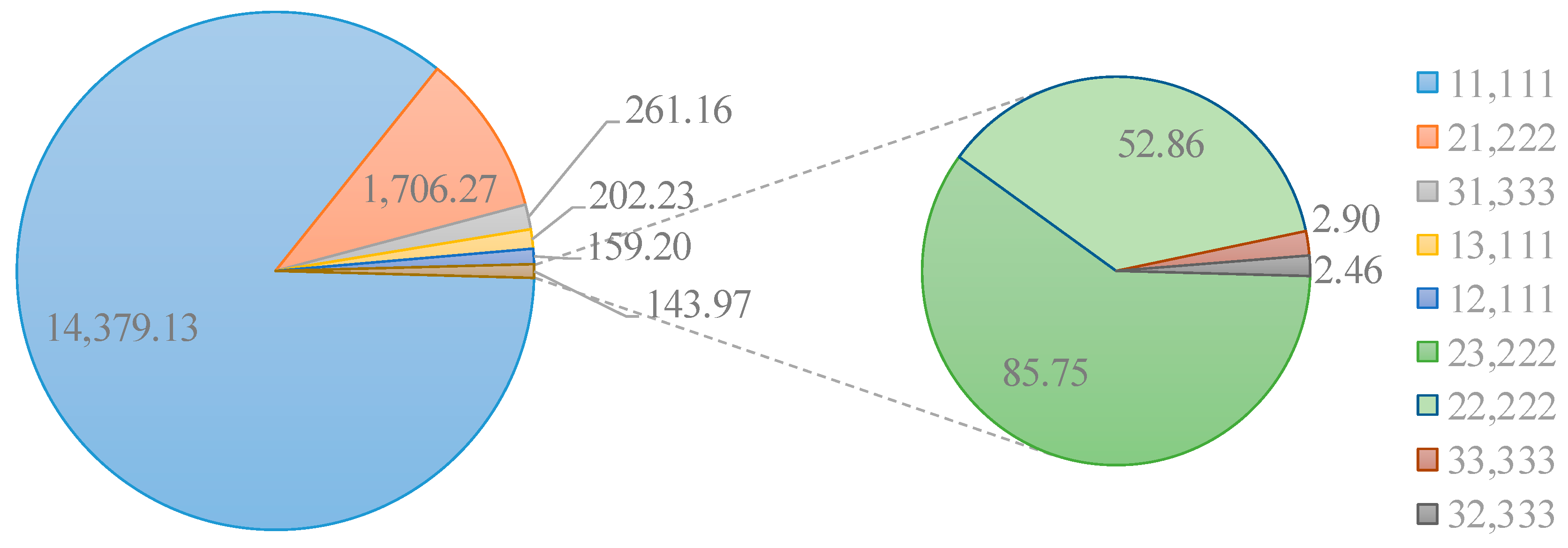
| Counties | Water Yield Services (m3·km−2) | Soil Conservation Services (t·km−2) | Carbon Retention Services (t·km−2) | Food Supply Services (t·km−2) | Leisure and Entertainment Services | |||||
|---|---|---|---|---|---|---|---|---|---|---|
| Supply | Demand | Supply | Demand | Supply | Demand | Supply | Demand | Supply | Demand | |
| Shangcheng | 116,546.33 | 95,501.74 | 10.59 | 0.37 | 302.55 | 18,430.29 | 0.009 | 17.946 | 0.146 | 0.104 |
| Xiacheng | 129,198.27 | 14,3870.95 | 16.02 | 0.05 | 190.31 | 30,662.13 | 0.004 | 29.856 | 0.058 | 0.172 |
| Jianggan | 113,478.94 | 8293.06 | 11.78 | 0.44 | 205.37 | 12,063.33 | 9.189 | 11.746 | 0.049 | 0.068 |
| Gongshu | 111,746.62 | 27,764.64 | 20.37 | 0.48 | 310.96 | 13,958.39 | 0.005 | 13.591 | 0.120 | 0.078 |
| Xihu | 84,199.26 | 2625.24 | 30.44 | 0.63 | 555.14 | 5747.85 | 6.865 | 5.597 | 0.367 | 0.032 |
| Binjiang | 117,642.01 | 25,410.19 | 8.74 | 0.56 | 244.91 | 12,858.50 | 16.452 | 12.520 | 0.078 | 0.072 |
| Xiaoshan | 83,535.33 | 385.14 | 20.54 | 0.78 | 399.24 | 4050.26 | 48.395 | 3.944 | 0.191 | 0.023 |
| Yuhang | 74,897.93 | 311.22 | 27.68 | 0.70 | 565.70 | 2772.74 | 36.566 | 2.700 | 0.350 | 0.016 |
| Fuyang | 62,906.02 | 87.93 | 50.41 | 0.40 | 886.23 | 1158.99 | 22.301 | 1.129 | 0.715 | 0.007 |
| Lin’an | 60,468.36 | 27.38 | 30.52 | 0.22 | 1038.57 | 620.06 | 14.401 | 0.604 | 0.855 | 0.003 |
| Tonglu | 61,657.02 | 27.90 | 37.19 | 0.17 | 983.21 | 370.78 | 16.530 | 0.361 | 0.801 | 0.002 |
| Chun’an | 70,967.40 | 4.43 | 25.11 | 0.09 | 962.67 | 141.77 | 14.486 | 0.138 | 0.818 | 0.001 |
| Jiande | 63,334.48 | 27.51 | 46.42 | 0.40 | 985.59 | 461.38 | 22.045 | 0.449 | 0.829 | 0.003 |
| Hangzhou | 68,721.60 | 1926.08 | 32.70 | 0.32 | 873.02 | 1396.64 | 20.727 | 1.331 | 0.701 | 0.008 |
| Districts and Counties | Water Yield | Soil Conservation | Carbon Retention | Food Supply | Leisure and Entertainment | Comprehensive Supply–Demand Ratio |
|---|---|---|---|---|---|---|
| Shangcheng | −0.106 | 0.029 | −0.818 | −0.397 | 0.077 | −0.243 |
| Xiacheng | −0.439 | 0.045 | −1.376 | −0.661 | −0.209 | −0.528 |
| Jianggan | 0.081 | 0.032 | −0.535 | −0.057 | −0.034 | −0.103 |
| Gongshu | 0.015 | 0.056 | −0.616 | −0.301 | 0.076 | −0.154 |
| Xihu | 0.161 | 0.085 | −0.234 | 0.028 | 0.609 | 0.130 |
| Binjiang | 0.073 | 0.023 | −0.569 | 0.087 | 0.010 | −0.075 |
| Xiaoshan | 0.211 | 0.056 | −0.165 | 0.984 | 0.307 | 0.279 |
| Yuhang | 0.217 | 0.077 | −0.100 | 0.749 | 0.609 | 0.310 |
| Fuyang | 0.219 | 0.142 | −0.012 | 0.469 | 1.291 | 0.422 |
| Lin’an | 0.226 | 0.086 | 0.019 | 0.305 | 1.552 | 0.438 |
| Tonglu | 0.238 | 0.105 | 0.028 | 0.358 | 1.455 | 0.437 |
| Chun’an | 0.283 | 0.071 | 0.037 | 0.318 | 1.489 | 0.440 |
| Jiande | 0.242 | 0.131 | 0.024 | 0.478 | 1.506 | 0.476 |
| Hangzhou | 0.236 | 0.092 | −0.022 | 0.429 | 1.263 | 0.399 |
| Service Relationship | Proportion of Area (%) | Subclass | Proportion of Area (%) | Supply Capacity Mix * | Proportion of Area (%) | Samples ** |
|---|---|---|---|---|---|---|
| Trade off | 98.11 | Strong trade-off | 1.89 | 1H4L | 1.89 | 11,311; 31,111 |
| Weak tradeoff | 96.22 | 1H1M3L | 0.08 | 12,311; 32,111; 21,131 | ||
| 1H2M2L | 7.91 | 21,231; 21,213; 23,211 | ||||
| 1H3M1L | 6.87 | 21,232; 21,223; 22,213; 22,231 | ||||
| 2H1M2L | 30.26 | 11,323; 21,313; 12,313; 31,132; 11,332; 31,123; 31,213; 12,331; 32,113; 32,131 | ||||
| 2H2M1L | 7.36 | 12,323; 21,233; 12,332; 21,323; 23,213; 32,123; 32,132; 31,223; 23,231; 22,313; 32,213 | ||||
| 2H3L | 28.58 | 11,313; 31,113; 31,131; 11,331; 33,111 | ||||
| 2M3L | 0.36 | 21,211 | ||||
| 3H1M1L | 5.12 | 13,323; 12,333; 13,332; 32,133; 33,123; 31,323; 33,132; 23,313; 32,313; 33,213; 32,331 | ||||
| 3H2L | 8.26 | 11,333; 13,313; 31,133; 13,331; 33,113; 31,313; 31,331; 13,311; 33,131 | ||||
| 4H1L | 1.4 | 13,333; 33,133; 33,313; 31,333 | ||||
| Synergy | 1.89 | High synergy | 1.89 | 4M1H | 0.96 | 22,223; 22,232 |
| 2H3M | 0.75 | 22,233; 22,323; 23,223; 23,232 | ||||
| 3H2M | 0.18 | 23,233; 23,323; 32,223; 32,323; 33,223 | ||||
| 4H1M | 0 | 33,323 | ||||
| Low synergy | 0 | 3M2L | 0 | 22,211 |
| Influencing Factors | Ecosystem Supply Services | ||||
|---|---|---|---|---|---|
| Water Yield | Soil Conservation | Carbon Retention | Food Supply Service | Leisure and Entertainment | |
| Forest area | 0.795 ** | 0.638 ** | 0.989 ** | 0.533 ** | 0.677 ** |
| Developed land area | 0.550 ** | −0.840 ** | −0.472 | 0.127 | −0.376 |
| DEM | 0.474 | −0.059 | 0.689 ** | −0.481 | 0.647 ** |
| Slope | 0.204 | 0.944 ** | 0.116 | 0.006 | 0.039 |
| Annual precipitation | −0.059 | −0.164 | 0.367 | −0.426 | 0.505 ** |
| Annual average temperature | 0.214 | 0.141 | −0.426 | 0.422 | −0.501 ** |
| Population density | 0.374 | −0.062 | −0.406 | 0.160 | −0.603 ** |
Publisher’s Note: MDPI stays neutral with regard to jurisdictional claims in published maps and institutional affiliations. |
© 2021 by the authors. Licensee MDPI, Basel, Switzerland. This article is an open access article distributed under the terms and conditions of the Creative Commons Attribution (CC BY) license (https://creativecommons.org/licenses/by/4.0/).
Share and Cite
Tian, P.; Li, J.; Cao, L.; Pu, R.; Gong, H.; Zhang, H.; Chen, H.; Yang, X. Assessing Matching Characteristics and Spatial Differences between Supply and Demand of Ecosystem Services: A Case Study in Hangzhou, China. Land 2021, 10, 582. https://doi.org/10.3390/land10060582
Tian P, Li J, Cao L, Pu R, Gong H, Zhang H, Chen H, Yang X. Assessing Matching Characteristics and Spatial Differences between Supply and Demand of Ecosystem Services: A Case Study in Hangzhou, China. Land. 2021; 10(6):582. https://doi.org/10.3390/land10060582
Chicago/Turabian StyleTian, Peng, Jialin Li, Luodan Cao, Ruiliang Pu, Hongbo Gong, Haitao Zhang, Huilin Chen, and Xiaodong Yang. 2021. "Assessing Matching Characteristics and Spatial Differences between Supply and Demand of Ecosystem Services: A Case Study in Hangzhou, China" Land 10, no. 6: 582. https://doi.org/10.3390/land10060582
APA StyleTian, P., Li, J., Cao, L., Pu, R., Gong, H., Zhang, H., Chen, H., & Yang, X. (2021). Assessing Matching Characteristics and Spatial Differences between Supply and Demand of Ecosystem Services: A Case Study in Hangzhou, China. Land, 10(6), 582. https://doi.org/10.3390/land10060582








